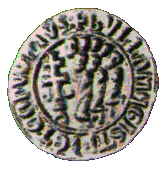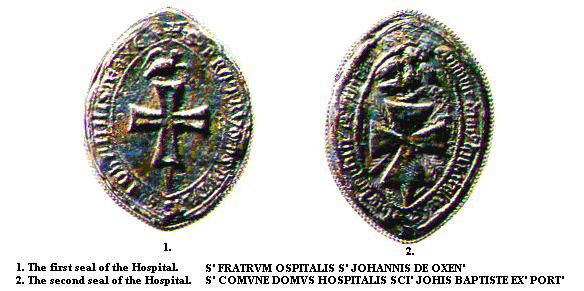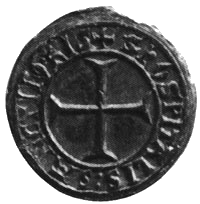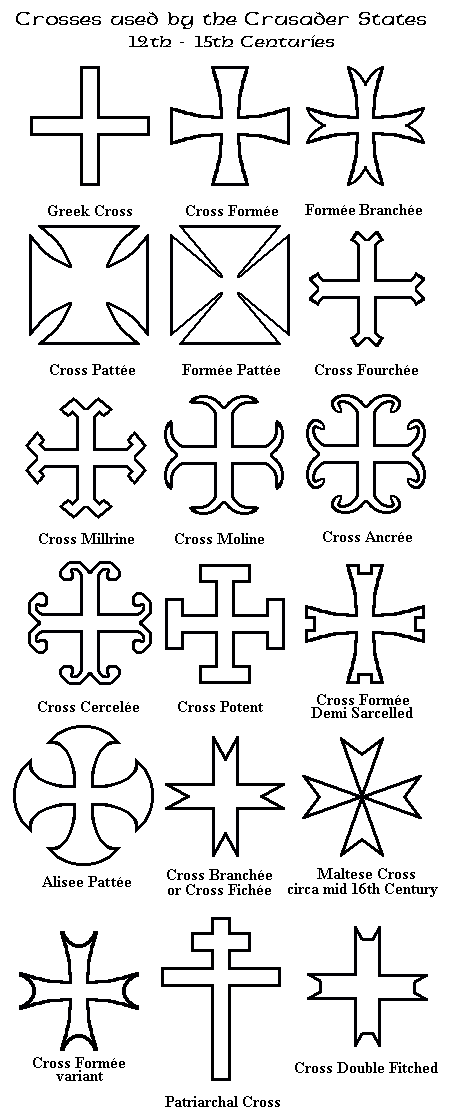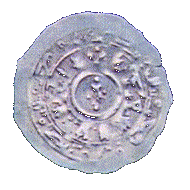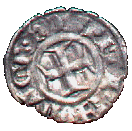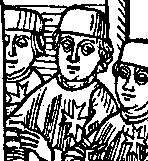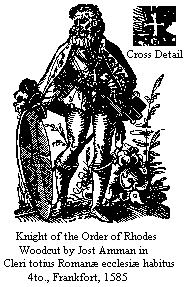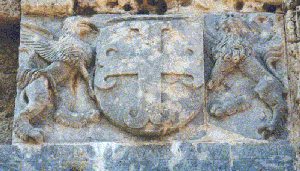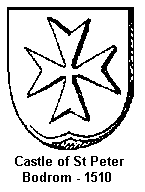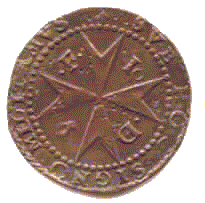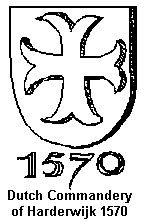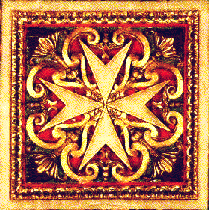History of the Maltese Cross,
as used by the Order of St John of Jerusalem.
© Copyright 2004 The Reverend Dr Michael Foster.
| Whilst the history of the Order has gained the attention of
a good number of historians, there has been no real critical appraisal on
when and how the eight-pointed Maltese Cross was introduced into the Order
of St John of Jerusalem. This is a matter which has escaped the attentions
of those otherwise respected as academics, who by failing to investigate
this aspect, continue to allow myth to replace historical reality.
Defining what we mean by the "Maltese Cross".
Given this description, no seal, painting, or drawing which concerns the Order, that is not anachronistic (i.e. produced later, to represent an earlier period), before the mid-late 1500s, portrays the now familiar eight pointed cross. History questioned. Fortunately, King has provided further insights to the problem in his published research on the Seals of the Order, which provides examples of the various forms of the crosses used by the Order, throughout the centuries #2. |
||
|
The Cross on the original Great Seal of the Convent of St John in Jerusalem is the True Cross (depicted in image as a Patriarchal Cross), which adds an upper crossbar (inscription-plate) #3. The arms of the cross are slightly fluted. The Patriarchal Cross may have been the initial form of Cross used by the Order. Some evidence of the first form of cross is given by Elias Ashmole writing about the Knights Templar in 1715; "Their Habit was white, to which, in the time of Eugenius III they added the Red Cross, and of the same Form that the Hospitallers wore (Favin says a Patriarchal Cross) and sowed it on the left shoulder of the Maulles" #4. The depiction of devotion to the True Cross, is also one found on coins of the Kingdom of Jerusalem, and may only have been an image to depict that the Order was "of Jerusalem". |
fig. 1. |
|
|
The early use of a Cross. If the Patriarchal Cross was the first form of cross, then it soon gave way to an equally early form of cross used by the Order, that of the Cross Formée (a Greek Cross with fluted arms). This cross can be seen on the wall of the stairs leading to the chapel within the Krak des Chevaliers which was the Syrian Castle of the Hospitallers from 1144 to 1271. A good example of early forms of the cross are provided by the two seals of the Oxford Hospital circa 1234 and later. These are in the form of Cross Formée and Pattée Formée, both with Fitch at Foot (fig. 2.) #5. Other examples are to be found in King #6. fig. 2. Crusader State Coins. |
||
|
As to the early written descriptions of an eight pointed cross, these could include Cross Moline, Cross Ancrée, Formée Pattée, a stylised Cross Formée or Cross Pattée, or Cross Branchée/ Fichée. Such versions of the cross were depicted in use by the Order prior to the sixteenth Century. In surveying the evidence of the forms of crosses used by the Order in Rhodes and in the early period at Malta, we must take note that the designs to be found on the Order's coinage were not exclusive to the Order, and that such crosses are to be found on the coins of other Crusader states. For example a Christian Arabic dinar or bezant of Acre 1257, which from the cross portrayed, could be argued as a Maltese Cross coin! The image seems to be a combination of a Cross Formée and a Cross Moline, but are almost identical to that on the gigliats of Helion de Villeneuvre, a Grand Master of Rhodes 1319-1346. Similar designs are to be found on Coinage from the Principality of Antioch, Lordship of Sidon, Cilician Armenia, Duchy of Athens, Lordship of Chios (a striking example is that of a quarter-gigliato prior to 1466). |
fig. 3. |
|
|
fig. 4. |
||
| The influence of Amalfi. One correspondent to the Sunday Times of Malta, the late Tony Borg-Cardona writes; "The display of crosses on coins of the Grand Masters in these centuries does not differ significantly from crosses on the coins of the Crusading States in the same period....This then brings us to question the claimed Amalfi origins, and to ask which ancient authority first made the claim, and whether the claim now needs to be revised?" #7. |
||
|
The coin used by the Amalfitans in their commercial exchanges was the Tari. The word Tari meant freshly minted. The coins were 12 carat and were made of equal parts of gold and silver mixed with a small quantity of copper. As far back as the 11th century Amalfi issued gold Tari from its own mint. One one side of the Tari there is an emblem, which is given to be the source of the eight pointed cross (fig. 5.). Four 'v's in square formation, are supplemented with a globe in the open arms of the 'v's. From a sight of the coin, the dependence of the Order's evolving cross on the Tari is far from conclusive, and can be discounted, especially as the Order appears to have used the Cross Formée in the 12th and 13th centuries. |
fig. 5. |
|
| The Evidence from Rhodes - The Rhodian Cross. A Rhodian Coin circa 1319-1360 (fig. 6.) provides an image much like that on the Seal of the Priory of Manosque, France of 1216. It is most likely that the coin is early 14th Century rather than late 14th Century. This Cross Moline of the Order (if it was in regular use) was eventually displaced by a variant of the Cross Formée with a concave or "v" ends, as witnessed by the artwork which emerged after the Seige of 1480. |
|
|
|
If any retouching of the illuminations is discounted then
Caoursin's work does not appear to be consistent. However defending the
originality of the cross detail in the illuminations, is a 1304 illumination
from the Liber Indulgentiae showing a similar design to that
found in Caoursin's Siege of Malta. Yet other drawings of the Knights in the
same period show a Cross Moline/Cross Ancrée #10. |
fig. 7. |
|
|
fig. 8. |
||
| Confirming the detail in the etching of Coursin (of the
Rhodian Cross), is a woodcut, and although of the late 16th Century (i.e.
when the Knights were in Malta), it portrays a Knight of Rhodes, where the
cross's ancerated ends are very modest (fig. 9.)
#11. A contemporary confirmation is found on the wall of Bodrum
Castle dated to 1510 (fig. 11)
#12. The Rhodian Cross persisted in the beginning period of the
Knights new home in Malta, as late as the mid 1500s, as evidenced on a coin
of Grand Master Sengle (fig. 12.).
We can conclude that whilst the Rhodian Cross appears to be the form that
was used in the 15th Century onwards, some artwork depicting the Order's
crosses of that period, suggest a less consistent picture. We cannot
discount that the brush of the Artist may have stumbled accidentally on the
modern design! |
fig. 9. |
|
|
Arms of Pierre d'Aubusson In Rhodes, the Arms of Pierre d'Aubusson are
portrayed at the gate Aghiou Athanasiou. |
||
|
Shield with Rhodian Cross |
||
|
The Arms of Peter d'Aubusson (fig. 10.) may have influenced the evolving cross of the Order. D'Aubusson continued as Grand Master until 1503, with continued evidence of the use by the Order of the ancerated Cross Formée, and the Cross Ancrée. For example coins of the period display the Cross Ancrée, such as the asper and billon denier. A denier issued under Grand Master Emeric d'Amboise provides a Cross Moline. The Cross Moline and Cross Ancrée were stylised Greek crosses, with the ends dividing, tapering, and leading off, right and left, or curved round to form an anchor end. |
||
|
The Evolution of the Maltese Cross. From the evidence of the Seals, the Cross Formée and Cross Pattée (a thicker form of Cross with definite fluted arms) with a variant form in the Pattée Formée (almost four triangles in square formation) were used in the 12th and 13th centuries. Some variations of the Cross Formée/Pattée had concave ends to the arms, moving the design toward the eight pointed cross. Local variations of the cross used by the Order such as the Cross Moline used on the Seal of the Priory of Manosque, France early 13th century provided an influence toward an eight pointed cross used in the following century. By the 14th century there is a regular portrayal of an eight pointed cross, such as the Cross Moline or Cross Ancrée, contributing to the evolutionary design. The uncertain design of the Order's cross in the late 12th century and throughout the 13th century, will reflect the uncertain future the Order faced following the loss of Jerusalem in 1187. Convents were secured in Tyre; 1187, Acre; 1191, Cyprus; 1291. Following the conquest of Rhodes by the Order, the Order was to enjoy a 300 year period of settled existence. In this period a definite form of the eight pointed cross emerged. This was represented by a Cross Formée Branchée/ Fichée, (the Rhodian Cross). The arms of the Rhodian Cross had almost, but not quite, achieved the straight lined sharp arrowhead appearance, noted from the mid 16th century onwards. Other Authors and their comments on the evolution of the Cross. |
||
|
The introduction of the Maltese Cross into the Order. In the mid 1500s, when the Knights are at Malta, the familiar design now known as the "Maltese Cross" makes its appearance. With some exceptions, all portrayals of the Cross of the Order become Maltese, even those portraying earlier figures and events in the Order. This is the beginning of the myth. So how and when was the Maltese Cross introduced into the Order? The first evidence of the modern Maltese Cross appears on the 2 Tari and 4 Tari Copper (fig. 13.) coins of the Grand Master Jean de la Vallette-Parisot (Grand Master 1557-1568). The 2 and 4 Tari Copper coins are dated 1567. This provides a date for the introduction of the Maltese Cross into the Order. For a period older forms of the Order's Cross persisted such as that at the Dutch Commandery of Harderwijk (fig. 14.). |
||
|
Picciolo of Grand Master Claude de la
Sengle Not Dated but circa 1553-1557 |
4 Tari Maltese Coin 1567 |
"For a period older forms of the Order's
Cross persisted." |
|
Possible explanations. Hospitaller Nuns of Sixena. Louis de Boisgelin, a Knight of the Order in Malta, prior to the events of their ejection by Napoleon, may provide some clues in the details about the Nuns of Sixena, who were originally a part of the Order of St John but had, at the end of the fifteenth century, separated to come under the direct authority of the Pope. Writing about their returned to the obedience of the Order in 1569, he describes their emblem as a "white cross with eight points" #18. There would have been discussions well before the date of their return, and within Vallette's time. The reconciliation of the Nuns might offer some insights to the origins of the introduction of the Maltese Cross into the Order. Boisgelin's attention to the detail of the cross, suggests en passant, that it was novum to the Order. Its introduction at that point in time fits in with its historic appearance at about the same time. Further research is needed on the use of the eight pointed cross by the Nuns of Sixena, beyond the scope of this monograph, which might affirm or discount this theory.
|
||
| The Great Siege of Malta. In terms of any "time line" for the Order, the introduction of the modern form of the "eight pointed" Cross, with its straight geometrical lines, is post the Great Siege of Malta. Fresh architectural input came from the building of Valletta. For example, any visitor to such as the Co-Cathedral of St John (built between 1573 and 1577) cannot escape the preponderance of examples of the new form of eight pointed cross (today known as the Maltese Cross) throughout the Cathedral (fig 15.). The chief buildings of the new city, also provide a celebration of the new cross. Researchers may not have to look much further, for the building of Valletta as being the genesis as providing the final form of the evolved cross of the Order. |
|
|
|
What is certain is that the Maltese Cross (as defined at the beginning of this monograph) was not adopted by the Order earlier than the mid sixteenth century (except anachronistically) #19, and thus it can be accepted with historic accuracy that the cross known to be the Maltese Cross was introduced in use to the Order of St. John of Jerusalem during their time in Malta. #1 King, Edwin J, The Knights
Hospitaller in the Holy Land, Methuen & Co. Ltd, London 1931,
footnote 5 , page 22.
Used with permission. Fr Foster, is an historic researcher, and is seeking to write a history on the Order following its expulsion from Malta, and is happy to hear from any source, which can provide details of organisations (Priories, or Orders) which alleged to be in lineal descent from the Order of St John which predates 1798. His email address is [email protected]. Fr Foster's postal address is; The Rectory, Church Hill, Tarrant Hinton, Blandford Forum, Dorset DT11 8JB, United Kingdom. |
||
